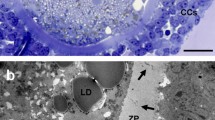Abstract
The kinetics of meiotic chromatin modifications and the function of lipidome in the oocytes that have completed their in vivo or in vitro growth phase after a prolonged culture period have been analyzed in order to improve the efficiency of a technology for extracorporeal maturation of porcine donor-derived oocytes. It is revealed that a prolonged period (up to 50 h) of culturing in the Sage Cleavage medium (CooperSurgical, United States) with the addition of 5% Serum Protein Substitute supplement (Cooper Surgical, United States) and 10 IU human chorionic gonadotropin can provoke destruction of chromatin of BCB+-positive and BCB–-negative oocytes (76 vs. 50%, P < 0.01). The age-associated porcine oocyte processes are usually followed by changes in lipid droplet morphology, since the granules tend to transform into clusters. A high percent of BCB–-negative oocytes containing normal chromatin in metaphase 2 can indicate the capability of oocytes that have not completed their in vivo growth phases to complete it in vitro with the subsequent meiotic maturation. The produced data may be used to model the maturation systems for porcine female gametes that have not completed their in vivo growth phases.




Similar content being viewed by others
REFERENCES
Prathnes, S., Hawley, R.J., Carter, D.B., Lai, L., and Greenstein, J.L., Transgenic swine for biomedicine and agriculture, Theriogenology, 2003, vol. 59, no. 1, pp. 115–123.
Aigner, B., Renner, S., Kessler, B., Klymiuk, N., Kurome, M., Wünsch, A., and Wolf, E., Transgenic pigs as models for translational biomedical research, J. Mol. Med., 2010, no. 88, pp. 653–664.
Niemann, H. and Petersen, B., The production of multi-transgenic pigs: Update and perspectives for xenotransplantation, Transgenic Res., 2016, vol. 25, no. 3, pp. 361–374.
Dyck, M.K., Zhou, C., Tsoi, S., Grant, J., Dixon, W.T., and Foxcroft, G.R., Reproductive technologies and the porcine embryonic transcriptome, Anim. Reprod. Sci., 2014, vol. 149, nos. 1–2, pp. 11–18.
Kuz’mina, T.I., Novichkova, D.A., and Volkova, N.A., In vitro modeling of porcine oocyte maturation systems, S-kh. Biol., 2013, no. 2, pp. 52–57.
Ishizaki, C., Developmental competence of porcine oocytes selected by brilliant cresyl blue and matured individually in a chemically defined culture medium, Theriogenology, 2009, vol. 72, no. 1, pp. 72–80.
Fu, B., Ran, L., Liu, D., Ma, J.-Z., An, T.-Z., and Bay, J., Sub cellular characterization of porcine acolytes with different glucose-6-phosphate dehydrogenises activities Asian-Australas. J. Anim. Sci., 2015, vol. 28, no. 12, pp. 1703–1712.
Prates, E.G., Nunes, J.T., and Pereira, R.M., A role of lipid metabolism during cumulus-oocyte complex maturation: Impact of lipid modulators to improve embryo production, Mediators Inflammation, 2014, vol. 2014, pp. 692096–692107.
Welte, M.A., Expanding roles for lipid droplets, Curr. Biol., 2015, no. 25, pp. R470–R481.
Kuz’mina, T.I., Torner, Kh., and Al’m, Kh., Metody polucheniya embrionov svinei in vitro: Metodicheskie rekomendatsii (Methods of Obtaining Pig Embryos in vitro: Guidelines), St. Petersburg: Pushkin, 2008.
Egerszegi, I., Meiotic progression, mitochondrial features and fertilization characteristics of porcine oocytes with different G6PDH activities, Reprod. Fertil. Dev., 2010, no. 22, pp. 830–838.
Reader, K.L., Stanton, J.-A.L., and Juengel, L.J., The role of oocyte organelles in determining developmental competence, Biology, 2017, no. 6, p. 35.
Niu, Y., Wang, Ch., Xiong, Q., Yang, X., Chi, D., Li, P., Liu, H., Li, J., and Huang, R., Distribution and content of lipid droplets and mitochondria in pig parthenogenetically activated embryos after delipation, Theriogenology, 2015, no. 83, pp. 131–138.
Budna, J., Celichowski, P., Bryja, A., Jeseta, M., Jankowski, M., Bukowska, D., Antosik, P., Nowicki, A., Brüssow, K.P., Bruska, M., and Nowicki, M., Expression changes in fatty acid metabolic process related genes in porcine oocytes during in vitro maturation, Med. J. Cell Biol., 2018, vol. 6, no. 2, pp. 48–54.
Ago, Q., The lipid droplet—a well-connected organelle, Front. Cell Dev. Biol., 2015, vol. 3, p. 49.
Dunning, K.R., Russell, D.L., and Robker, R.L., Lipids and oocyte developmental competence: The role of fatty acids and β-oxidation, Reproduction, 2014, vol. 148, no. 1, pp. R15–R27.
Funding
This work was carried out with the financial support of the Russian Foundation for Basic Research (project no. 18-016-00147A).
Author information
Authors and Affiliations
Corresponding author
Ethics declarations
Conflict of interest. The authors declare that they have no conflict of interest.
Statement of welfare of animals. All applicable international, national, and/or institutional guidelines for the care and use of animals were followed. The article does not concern any researches using animals as objects.
Additional information
Translated by O. Zhiryakova
About this article
Cite this article
Kuzmina, T.I., Chistyakova, I.V. & Starikova, D.A. Meiotic Maturation and Function of Lipidome in Porcine Oocytes That Have Completed Their In Vivo or In Vitro Growth Phase after a Prolonged Culture Period. Russ. Agricult. Sci. 46, 314–318 (2020). https://doi.org/10.3103/S1068367420030106
Received:
Revised:
Accepted:
Published:
Issue Date:
DOI: https://doi.org/10.3103/S1068367420030106




